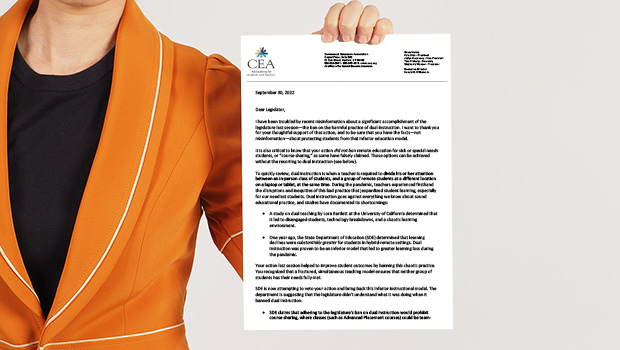Despite a legislative ban on dual teaching the State Department of Education last week issued guidance that allows the inferior instructional practice to continue.
CEA and AFT Connecticut held a news conference rejecting the new guidelines, and CEA President Kate Dias has since sent a letter to legislators explaining CEA’s position and asking them to ensure all students receive a quality education.
Read the full letter below.
Dear Legislator,
I have been troubled by recent misinformation about a significant accomplishment of the legislature last session—the ban on the harmful practice of dual instruction. I want to thank you for your thoughtful support of that action, and to be sure that you have the facts—not misinformation—about protecting students from that inferior education model.
It is also critical to know that your action did not ban remote education for sick or special needs students, or “course sharing,” as some have falsely claimed. Those options can be achieved without the resorting to dual instruction (see below).
To quickly review, dual instruction is when a teacher is required to divide his or her attention between an in-person class of students, and a group of remote students at a different location on a laptop or tablet, at the same time. During the pandemic, teachers experienced firsthand the disruptions and inequities of this bad practice that jeopardized student learning, especially for our neediest students. Dual instruction goes against everything we know about sound educational practice, and studies have documented its shortcomings:
-
- A study on dual teaching by Lora Bartlett at the University of California determined that it led to disengaged students, technology breakdowns, and a chaotic learning environment.
- One year ago, the State Department of Education (SDE) determined that learning declines were substantially greater for students in hybrid-remote settings. Dual instruction was proven to be an inferior model that led to greater learning loss during the pandemic.
Your action last session helped to improve student outcomes by banning this chaotic practice. You recognized that a fractured, simultaneous teaching model ensures that neither group of students has their needs fully met.
SDE is now attempting to veto your action and bring back this inferior instructional model. The department is suggesting that the legislature didn’t understand what it was doing when it banned dual instruction.
-
- SDE claims that adhering to the legislature’s ban on dual instruction would prohibit course sharing, where classes (such as Advanced Placement courses) could be team-taught or remotely taught. This is simply not true and can be easily accomplished through undivided remote instruction (instruction focused on engaging a remote cohort of students) or, when done within a district, by transporting students to a unified location (as is done every day for sports). Both models are far better for student learning than dual instruction.
- SDE says it is concerned with equity, but under its plan to allow dual instruction, many special education students, and students in our most under-resourced schools, would not have a certified teacher in the classroom. This is inequity and second-class education—not what the Sheff case intended. The legislature was right to prohibit the failed model that contributed to learning loss in all grade levels, as SDE’s own research noted in their Student Assessment Report of 2021.
- SDE suggests that dual instruction meets the standard of least-restrictive environments, but there is no evidence that this is correct. To the contrary, special needs students require specialized and engaged instruction, the opposite of what is provided through dual instruction. A better solution? Homebound instruction or undivided remote instruction. Both are vastly superior to dual instruction for those special needs students who cannot be served in a classroom setting.
If SDE is successful in creating harmful loopholes in the ban on dual instruction, we essentially throw in the towel on equity for all. Best practices for some, and inferior practices for others, is not equity. There are much better, evidence-based solutions, and Connecticut students deserve fairness and effective learning models.
Thank you for protecting student learning with the ban on dual instruction last legislative session. We look forward to working with you in the coming session to ensure that all students receive a quality education.
Sincerely,
Kate Dias
CEA President







